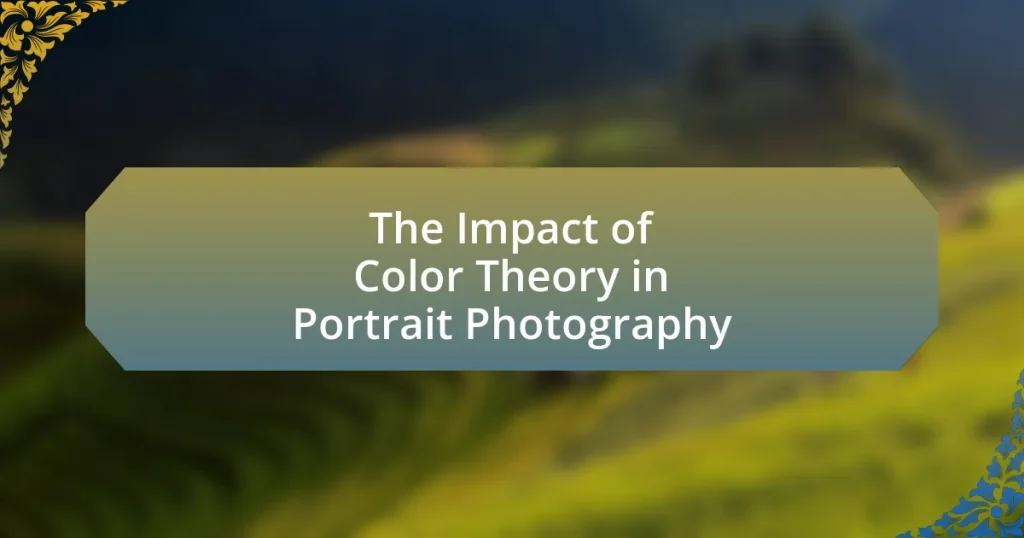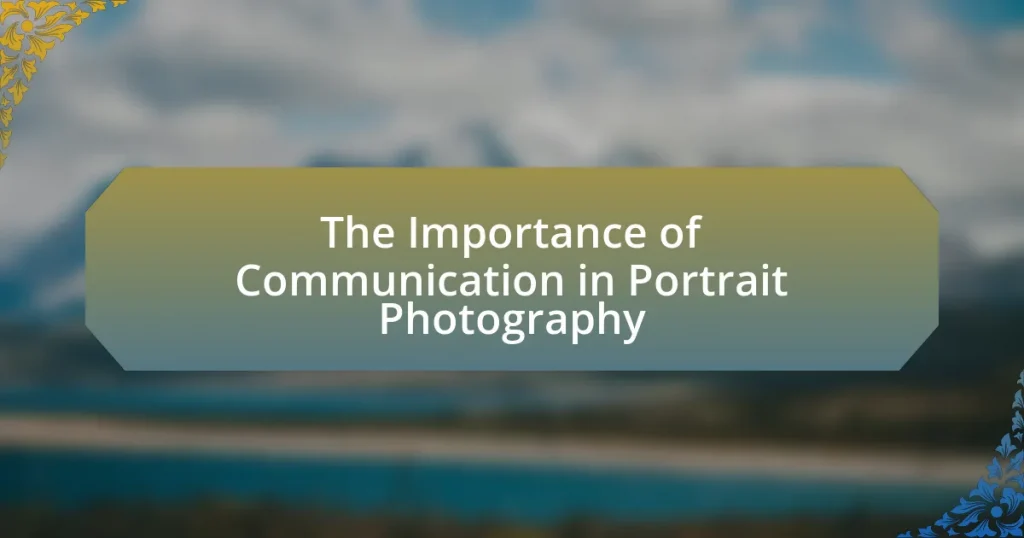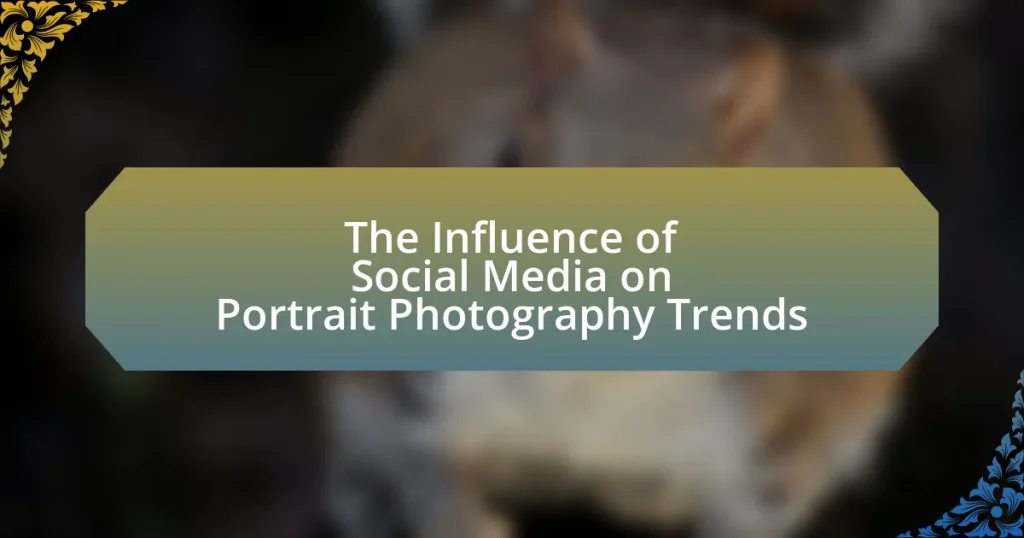The article examines the impact of color theory in portrait photography, highlighting how color influences emotional responses and visual appeal. It discusses the psychological effects of warm and cool colors, the importance of color harmony, and the role of color temperature in shaping the mood of portraits. Key principles such as hue, saturation, brightness, and the use of complementary colors are explored to enhance the subject’s features and storytelling aspects. Additionally, practical tips for selecting color palettes and avoiding common mistakes are provided, emphasizing the significance of understanding color theory for effective portrait photography.
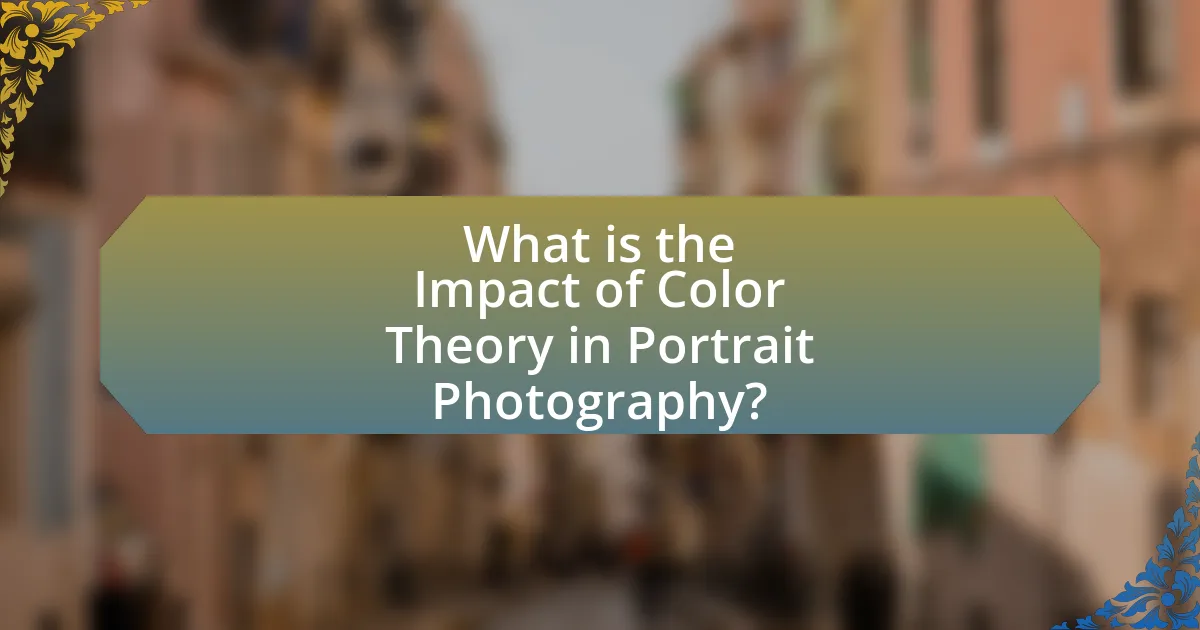
What is the Impact of Color Theory in Portrait Photography?
Color theory significantly impacts portrait photography by influencing the emotional response and visual appeal of the images. The use of color can evoke specific feelings; for instance, warm colors like reds and oranges can create a sense of warmth and intimacy, while cool colors like blues and greens can convey calmness and serenity. Studies in color psychology support these effects, indicating that colors can affect mood and perception. Additionally, the strategic use of complementary colors can enhance the subject’s features and create a more dynamic composition, making the portrait more engaging. This understanding of color relationships is essential for photographers aiming to communicate a particular message or emotion through their work.
How does color theory influence the perception of portraits?
Color theory significantly influences the perception of portraits by affecting emotional responses and visual harmony. Different colors evoke specific feelings; for instance, warm colors like red and orange can create a sense of warmth and energy, while cool colors like blue and green often convey calmness and tranquility. This emotional impact can alter how viewers interpret the subject’s personality and mood. Additionally, the use of complementary colors can enhance visual appeal and draw attention to the subject, making the portrait more engaging. Research indicates that color choices can affect viewer perceptions, with studies showing that portraits using harmonious color schemes are often rated more positively in terms of attractiveness and emotional resonance.
What are the basic principles of color theory relevant to photography?
The basic principles of color theory relevant to photography include the color wheel, color harmony, and the psychological effects of color. The color wheel organizes colors into primary, secondary, and tertiary categories, providing a visual guide for understanding relationships between colors. Color harmony refers to the aesthetically pleasing combinations of colors, such as complementary, analogous, and triadic schemes, which can enhance the visual impact of a photograph. The psychological effects of color influence viewer emotions and perceptions; for instance, warm colors like red and orange can evoke feelings of warmth and excitement, while cool colors like blue and green can create a sense of calm. These principles are essential for photographers to create compelling and emotionally resonant images.
How do different colors evoke emotions in portrait photography?
Different colors evoke specific emotions in portrait photography by influencing the viewer’s psychological response. For instance, warm colors like red and orange can evoke feelings of passion, energy, and warmth, while cool colors such as blue and green often convey calmness, tranquility, and sadness. Research in color psychology supports these associations; for example, a study published in the journal “Color Research and Application” by Andrew Elliot and Markus Maier indicates that warm colors can increase arousal and excitement, whereas cool colors tend to have a soothing effect. Thus, the strategic use of color in portrait photography can significantly impact the emotional tone and message conveyed in the image.
Why is understanding color theory essential for portrait photographers?
Understanding color theory is essential for portrait photographers because it enables them to create visually appealing images that evoke specific emotions and enhance the subject’s features. By mastering color relationships, photographers can effectively use complementary, analogous, and triadic color schemes to highlight the subject’s skin tones and convey mood. For instance, research indicates that warm colors can evoke feelings of warmth and comfort, while cool colors can create a sense of calmness or detachment. This knowledge allows photographers to make informed decisions about lighting, backgrounds, and wardrobe choices, ultimately leading to more impactful portraits.
How can color theory enhance the storytelling aspect of portraits?
Color theory enhances the storytelling aspect of portraits by using color to evoke emotions and convey narratives. For instance, warm colors like reds and oranges can create feelings of passion or warmth, while cool colors such as blues and greens can evoke calmness or sadness. This emotional resonance allows viewers to connect more deeply with the subject’s story. Research indicates that color can influence perception and mood; a study published in the journal “Color Research and Application” found that colors significantly affect emotional responses, reinforcing the idea that color choices in portraits can shape the viewer’s interpretation of the subject’s narrative.
What role does color play in the composition of a portrait?
Color plays a crucial role in the composition of a portrait by influencing the emotional tone and visual impact of the image. The choice of colors can evoke specific feelings, convey personality traits, and establish a mood, which is essential in portrait photography. For instance, warm colors like reds and oranges can create a sense of warmth and intimacy, while cool colors such as blues and greens may evoke calmness or detachment. Studies in color psychology indicate that colors can significantly affect viewer perception and emotional response, reinforcing the importance of color selection in portrait composition.
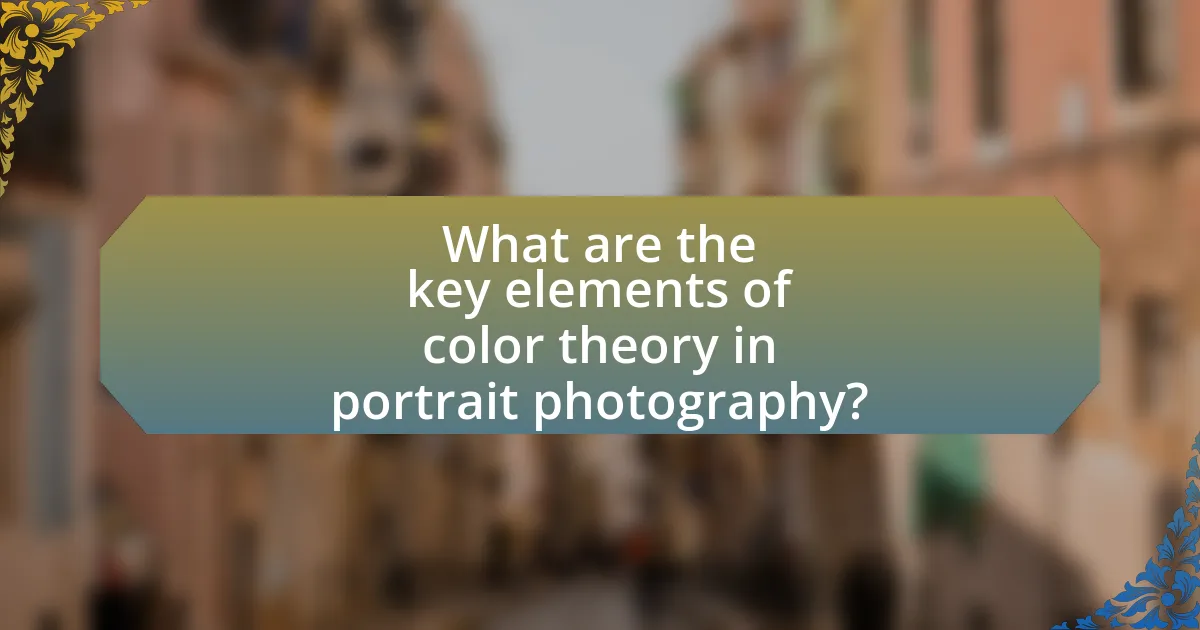
What are the key elements of color theory in portrait photography?
The key elements of color theory in portrait photography include hue, saturation, brightness, and color harmony. Hue refers to the specific color itself, such as red or blue, which can evoke different emotions and set the mood of the portrait. Saturation indicates the intensity of the color; highly saturated colors appear vivid and bold, while desaturated colors appear muted and soft, influencing the overall impact of the image. Brightness, or value, describes how light or dark a color is, affecting the contrast and depth in the portrait. Color harmony involves the combination of colors that are aesthetically pleasing together, such as complementary or analogous color schemes, which can enhance the visual appeal and emotional resonance of the photograph. These elements work together to create a cohesive and compelling portrait that communicates the intended message or feeling.
What are the primary colors and their significance in portrait photography?
The primary colors are red, blue, and yellow, and they hold significant importance in portrait photography by influencing mood, emotion, and visual impact. Red often conveys passion and energy, blue can evoke calmness and trust, while yellow typically represents happiness and optimism. These colors can be strategically used in clothing, backgrounds, and lighting to enhance the subject’s expression and the overall narrative of the portrait. For instance, a study by the American Psychological Association indicates that colors can affect human emotions and perceptions, reinforcing the idea that the choice of primary colors in portrait photography can significantly alter the viewer’s interpretation of the image.
How do complementary colors affect the visual impact of a portrait?
Complementary colors enhance the visual impact of a portrait by creating contrast that draws attention to the subject. When used effectively, these colors can make the subject stand out against the background, emphasizing features and expressions. For example, a portrait featuring a subject with warm tones, such as orange or red, paired with cool tones like blue or green, can create a dynamic visual effect that captures the viewer’s eye. This principle is supported by color theory, which states that complementary colors, located opposite each other on the color wheel, intensify each other when placed together, leading to a more vibrant and engaging image.
What is the role of color harmony in creating appealing portraits?
Color harmony plays a crucial role in creating appealing portraits by ensuring that the colors used complement each other, enhancing the overall aesthetic. When colors are harmonious, they evoke emotions and create a sense of balance, which is essential in portrait photography. Research indicates that harmonious color combinations can lead to increased viewer engagement and emotional response, as seen in studies on color psychology. For instance, a study published in the Journal of Experimental Psychology found that images with harmonious color schemes are perceived as more attractive and evoke positive feelings. Thus, effective use of color harmony not only improves visual appeal but also influences the emotional impact of portraits.
How can color temperature influence portrait photography?
Color temperature significantly influences portrait photography by affecting the mood and emotional tone of the image. Warmer color temperatures, typically around 3000K to 4000K, create a cozy and inviting atmosphere, enhancing skin tones and making subjects appear more approachable. Conversely, cooler color temperatures, ranging from 5000K to 6500K, can impart a more clinical or dramatic feel, often emphasizing shadows and textures in the subject’s features. Research indicates that color temperature can alter viewer perception; for instance, a study published in the Journal of Vision found that warmer light can evoke feelings of comfort and happiness, while cooler light can evoke feelings of sadness or detachment. Thus, understanding and manipulating color temperature is crucial for photographers aiming to convey specific emotions and narratives in portrait photography.
What is the difference between warm and cool colors in portraits?
Warm colors in portraits, such as reds, oranges, and yellows, evoke feelings of warmth, energy, and intimacy, while cool colors, including blues, greens, and purples, convey calmness, distance, and serenity. The use of warm colors can create a sense of closeness and emotional engagement, often making subjects appear more inviting. In contrast, cool colors can create a more detached or tranquil atmosphere, which may be suitable for conveying introspection or melancholy. This distinction is rooted in color theory, where warm colors are associated with sunlight and heat, while cool colors are linked to water and shade, influencing the viewer’s emotional response to the portrait.
How does lighting affect color temperature in portrait photography?
Lighting significantly influences color temperature in portrait photography by altering the perceived warmth or coolness of the colors in the image. Different light sources emit varying color temperatures measured in Kelvin; for instance, daylight typically ranges from 5000K to 6500K, producing a neutral to cool tone, while incandescent bulbs emit warmer light around 2700K to 3000K. This variation affects how skin tones and other colors appear in portraits, with warmer lighting enhancing reds and yellows, while cooler lighting emphasizes blues and greens. Understanding these effects allows photographers to manipulate lighting to achieve desired emotional and aesthetic outcomes in their portraits.
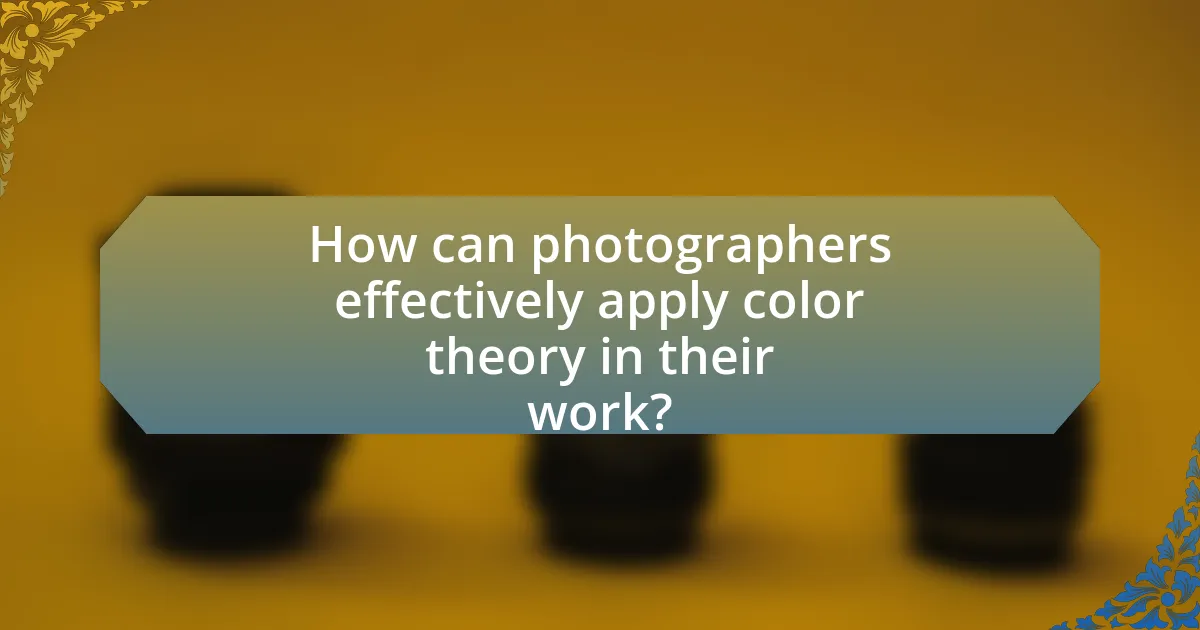
How can photographers effectively apply color theory in their work?
Photographers can effectively apply color theory in their work by understanding and utilizing the relationships between colors to evoke emotions and enhance visual storytelling. For instance, complementary colors, which are opposite each other on the color wheel, can create dynamic contrasts that draw attention to the subject, while analogous colors, which are next to each other, can produce harmonious and soothing images. Research indicates that color can influence viewer perception; a study published in the journal “Color Research and Application” by researchers from the University of California found that colors can significantly affect mood and emotional responses. By strategically selecting color palettes based on these principles, photographers can enhance the emotional impact of their portraits and create a more engaging viewer experience.
What techniques can photographers use to incorporate color theory in portraits?
Photographers can incorporate color theory in portraits by using complementary colors, analogous colors, and color harmony to enhance the emotional impact of their images. Complementary colors, which are opposite each other on the color wheel, create visual tension and draw attention to the subject, such as pairing blue clothing with an orange background. Analogous colors, located next to each other on the color wheel, provide a more harmonious and cohesive look, often used to evoke a sense of calm or unity, like using shades of blue and green in a portrait. Additionally, understanding color temperature—warm colors (reds, oranges) can evoke energy and passion, while cool colors (blues, greens) can convey tranquility—allows photographers to set the mood of the portrait effectively. These techniques are supported by studies in color psychology, which indicate that colors can significantly influence viewer emotions and perceptions.
How can color grading enhance the final look of a portrait?
Color grading can enhance the final look of a portrait by adjusting the hues, saturation, and brightness to create a specific mood or atmosphere. This process allows photographers to emphasize certain features, evoke emotions, and ensure color harmony within the image. For instance, warmer tones can convey intimacy and warmth, while cooler tones may evoke calmness or detachment. Studies in color psychology indicate that colors can significantly influence viewer perception and emotional response, reinforcing the importance of color grading in achieving the desired impact in portrait photography.
What are some common mistakes to avoid when using color theory in portraits?
Common mistakes to avoid when using color theory in portraits include neglecting skin tone compatibility, overusing saturated colors, and failing to consider the emotional impact of color. Neglecting skin tone compatibility can lead to unflattering results, as colors that clash with a subject’s natural complexion can distort their appearance. Overusing saturated colors may overwhelm the viewer and detract from the subject, making the portrait feel chaotic rather than harmonious. Additionally, failing to consider the emotional impact of color can result in portraits that do not convey the intended mood; for example, warm colors evoke feelings of warmth and comfort, while cool colors can create a sense of calm or sadness. Understanding these aspects of color theory is essential for creating effective and visually appealing portraits.
What practical tips can improve the use of color theory in portrait photography?
To improve the use of color theory in portrait photography, photographers should focus on complementary color schemes, which enhance the subject’s features and create visual interest. Utilizing colors opposite each other on the color wheel, such as blue and orange, can make the subject stand out against the background, drawing attention to the face. Additionally, understanding the emotional impact of colors can guide photographers in selecting palettes that evoke specific feelings; for instance, warm colors like reds and yellows can convey energy and passion, while cool colors like blues and greens can evoke calmness and serenity. Implementing color harmony through analogous colors, which are next to each other on the color wheel, can create a cohesive look that is visually pleasing. Lastly, considering the lighting conditions is crucial, as natural light can alter color perception, making it essential to adjust settings accordingly to maintain the intended color balance.
How can photographers choose the right color palette for their subjects?
Photographers can choose the right color palette for their subjects by analyzing the subject’s skin tone, clothing, and the emotional tone they wish to convey. Understanding color theory, including complementary and analogous colors, helps photographers create harmonious images that enhance the subject’s features. For instance, warm skin tones typically pair well with earthy colors, while cool skin tones may be complemented by jewel tones. Research indicates that color can evoke specific emotions; for example, blue often conveys calmness, while red can signify passion. By applying these principles, photographers can effectively select a color palette that not only flatters their subjects but also aligns with the intended mood of the portrait.
What tools and resources are available for mastering color theory in photography?
To master color theory in photography, photographers can utilize color wheels, online courses, and software tools. Color wheels help visualize relationships between colors, aiding in the selection of complementary and analogous color schemes. Online platforms like Skillshare and Coursera offer structured courses on color theory specifically tailored for photographers, providing both theoretical knowledge and practical applications. Additionally, software tools such as Adobe Color and Capture One allow photographers to experiment with color palettes and analyze color harmony in their images. These resources collectively enhance understanding and application of color theory in portrait photography.










